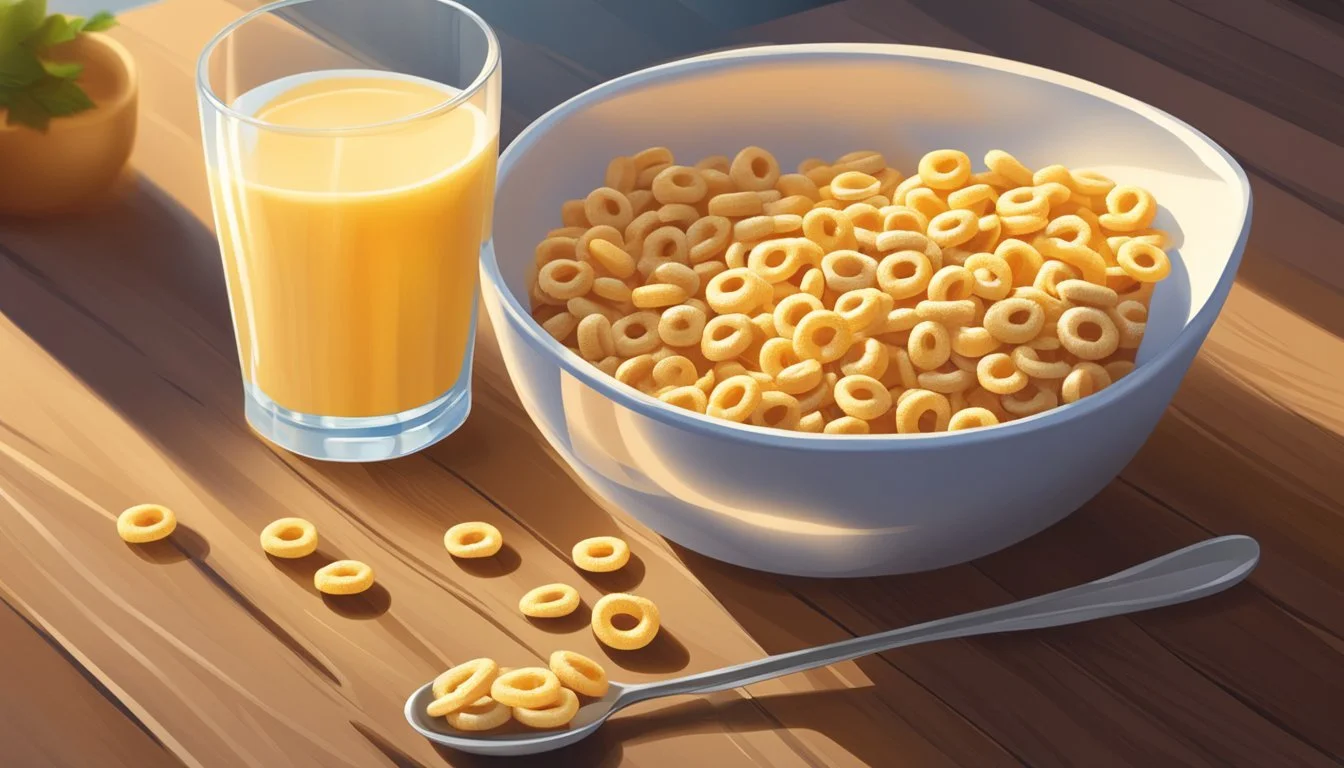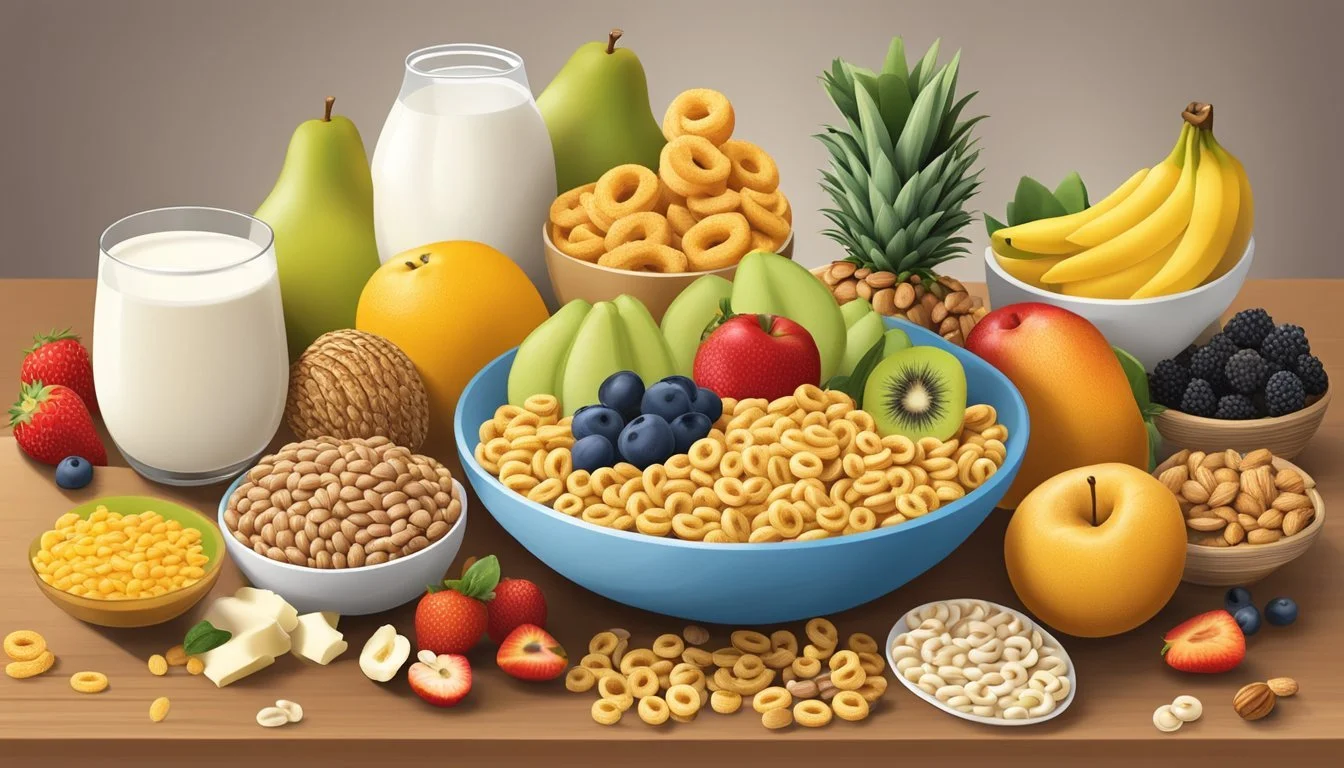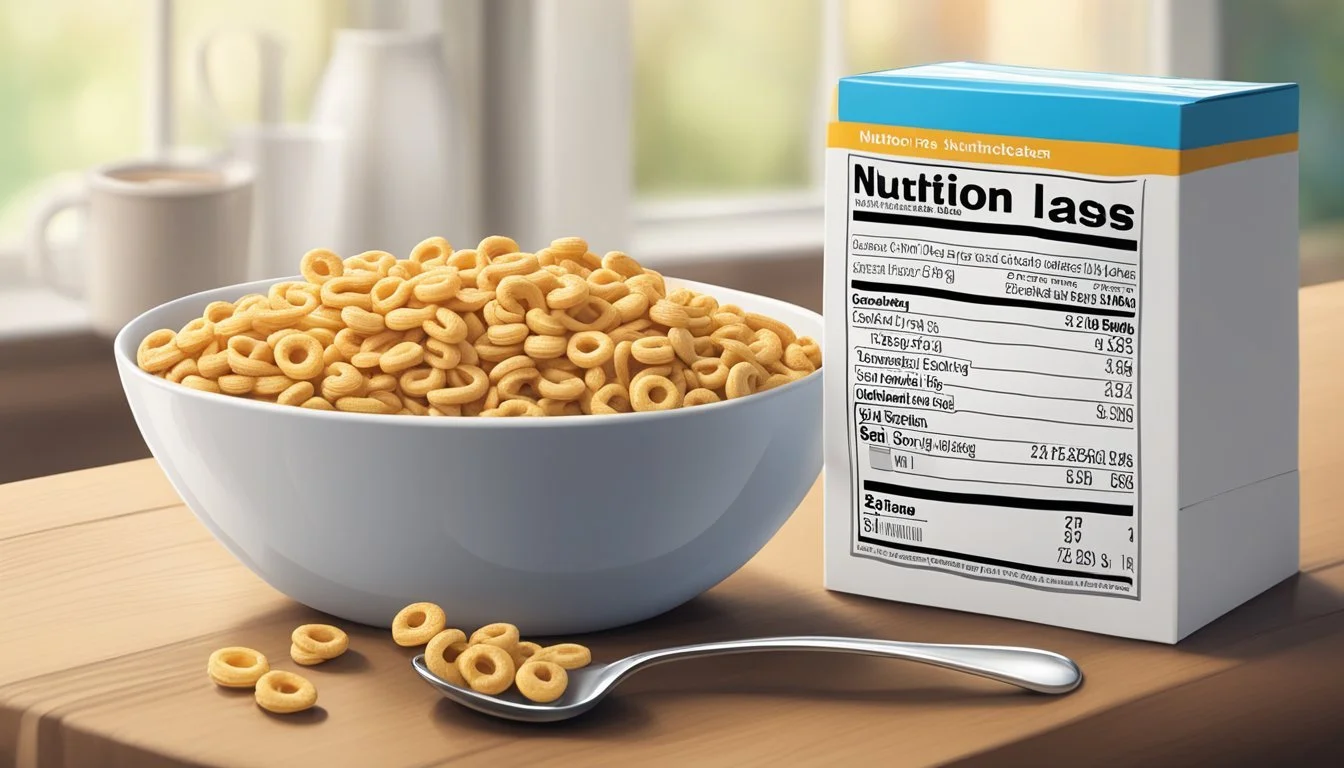Cheerios Nutrition Facts & More
Essential Facts for a Healthy Breakfast Choice
Cheerios, the iconic breakfast cereal from General Mills, has been a staple in many households for decades. Made primarily from whole grain oats, this popular breakfast choice offers several nutritional benefits. A single serving of Cheerios provides 34 grams of whole grains and 1.5 grams of soluble fiber, which may help lower cholesterol as part of a heart-healthy diet.
The nutritional profile of Cheerios extends beyond whole grains and fiber. The cereal is fortified with essential vitamins and minerals, including iron and vitamin D. These added nutrients contribute to its overall nutritional value, making it a more well-rounded breakfast option. Cheerios are also gluten-free, catering to individuals with gluten sensitivities or celiac disease.
While Cheerios offer various nutritional benefits, it's important to consider the complete picture. The cereal is relatively low in protein compared to other breakfast options. Some varieties of Cheerios contain added sugars, which consumers should be aware of when making dietary choices. Understanding the nutritional content of Cheerios can help individuals make informed decisions about incorporating this cereal into their balanced diet.
Cheerios Compared to Other Breakfast Cereals
Nutritional Profile
Cheerios provide a mix of essential nutrients from whole grain oats. They contain a balance of macronutrients and various vitamins and minerals to support overall health.
Macronutrients
A 1 1/2 cup (39g) serving of Cheerios contains 140 calories. This serving provides 3 grams of total fat, including 0.5g saturated fat and no trans fat. The cereal delivers 2g of protein and 29g of total carbohydrates. Of these carbs, 3g come from dietary fiber, with 1.5g being soluble fiber. Cheerios contain only 2g of sugars per serving, with 1g from added sugars.
Whole grain oats make up the primary ingredient in Cheerios, contributing to their fiber content. The low sugar and moderate calorie content make Cheerios a suitable option for those watching their calorie or sugar intake.
Vitamins and Minerals
Cheerios are fortified with several essential vitamins and minerals. A serving provides 20% of the Daily Value (DV) for vitamin D, supporting bone health. It also contains 60% DV for iron, crucial for oxygen transport in the body.
Other notable nutrients include:
Vitamin B12: 60% DV
Zinc: 40% DV
Vitamin A: 10% DV
Calcium: 10% DV
Cheerios also contain smaller amounts of thiamin, riboflavin, niacin, vitamin B6, and folate. These B-vitamins play vital roles in energy metabolism and nervous system function.
The cereal provides some potassium, phosphorus, and magnesium, contributing to various bodily functions including muscle and nerve function, and bone health.
Health Benefits
Cheerios offer several potential health benefits due to their nutritional composition. The whole grain oats and low sugar content contribute to positive effects on heart health, digestion, weight management, and blood sugar control.
Heart Health
Cheerios may support heart health through their whole grain oat content. Oats contain beta-glucan, a soluble fiber that can help lower cholesterol levels. A serving of Cheerios provides about 1 gram of soluble fiber, which contributes to the recommended daily intake for heart health.
The low fat and low sugar content of original Cheerios also align with heart-healthy dietary recommendations. With only 2 grams of sugar per serving, Cheerios have significantly less added sugar than many other breakfast cereals.
Regular consumption of whole grains like those in Cheerios is associated with reduced risk of heart disease. The American Heart Association recognizes Cheerios as a heart-healthy cereal option when part of a balanced diet.
Digestive Wellness
The fiber content in Cheerios supports digestive health. A serving provides about 3 grams of dietary fiber, which aids in regular bowel movements and promotes a healthy gut microbiome.
Whole grains in Cheerios act as prebiotics, feeding beneficial gut bacteria. This can lead to improved digestion and enhanced nutrient absorption.
The insoluble fiber in Cheerios adds bulk to stool, helping prevent constipation. It also supports overall intestinal health by promoting regular bowel movements.
Weight Management
Cheerios can be a helpful addition to a weight management plan. With only 140 calories per serving, they provide a low-calorie breakfast or snack option.
The fiber content in Cheerios helps increase feelings of fullness, potentially reducing overall calorie intake throughout the day. This satiety effect can support weight loss efforts or weight maintenance.
Cheerios are also low in fat, with only 2 grams per serving. This makes them a suitable choice for those following a low-fat diet regimen.
Blood Sugar Control
The whole grain oats in Cheerios have a low glycemic index, meaning they cause a slower and more gradual rise in blood sugar compared to refined grains. This can help with blood sugar management, especially important for individuals with diabetes or prediabetes.
The fiber in Cheerios also slows digestion, further contributing to steadier blood sugar levels. This can help prevent energy crashes and maintain more consistent energy throughout the day.
With only 2 grams of sugar per serving, original Cheerios have minimal impact on blood sugar compared to cereals with higher added sugar content. This makes them a better choice for those monitoring their carbohydrate intake.
Dietary Considerations
Cheerios offer options for various dietary needs and restrictions. The cereal's simple ingredients make it suitable for many consumers, though some considerations apply.
Allergen Information
Cheerios are made from whole grain oats, which are naturally gluten-free. However, the manufacturing process may introduce trace amounts of gluten. General Mills has implemented a rigorous process to remove stray wheat, rye, and barley from their oat supply.
For those with celiac disease or gluten sensitivity, Cheerios labeled as gluten-free are available. These undergo additional testing to ensure gluten levels are below 20 parts per million, meeting FDA standards for gluten-free products.
Cheerios do not contain common allergens like nuts, soy, or eggs. The original flavor is also dairy-free, making it suitable for those with lactose intolerance or milk allergies.
Special Diets
Cheerios align with several special diets. The original flavor is vegan and vegetarian-friendly, containing no animal products or by-products. This makes it a suitable breakfast option for plant-based eaters.
For those watching their sugar intake, original Cheerios contain only 1 gram of sugar per serving. This low sugar content makes them compatible with many low-sugar diets.
Cheerios are also heart-healthy, with 3 grams of soluble fiber per serving. This fiber can help lower cholesterol levels when consumed as part of a balanced diet.
The cereal is fortified with essential vitamins and minerals, supporting various nutritional needs. Its low calorie count (105 per cup) makes it suitable for weight management diets when portion-controlled.
Cheerios Varieties
Cheerios offers a diverse array of flavors and product options beyond the classic Original variety. The brand has expanded to include both sweetened and unsweetened choices, as well as alternative formats like snack bars.
Flavors and Options
Honey Nut Cheerios stands out as one of the most popular flavored varieties. It combines the signature oat rings with a honey and almond flavor. Other sweet options include Frosted Cheerios and Apple Cinnamon Cheerios, which incorporate brown sugar syrup for added taste.
For chocolate lovers, Chocolate Cheerios provides a cocoa-flavored alternative. Multigrain Cheerios offers a blend of five whole grains for added nutritional variety.
Cheerios also caters to various dietary needs. Gluten-free options are available for those with gluten sensitivities. Some varieties are fortified with additional vitamins and minerals to boost their nutritional profile.
Alternative Cheerios Products
Cheerios has expanded beyond traditional cereals to offer convenient on-the-go options. Cheerios Cereal Bars combine the familiar oat rings with a sweet coating, making them easy to eat without milk.
Yogurt-covered Cheerios provide a crunchy snack option. These feature the classic Os coated in a layer of yogurt for added flavor and texture.
Cheerios Snack Mix combines the cereal with nuts and other crunchy elements for a more diverse snacking experience. This option allows consumers to enjoy the familiar taste of Cheerios in a different format.
Consumption Tips and Ideas
Cheerios offer versatile options for enjoyment beyond a simple bowl of cereal. These wholesome oat rings can be incorporated into various meals and snacks for both adults and children.
Serving Suggestions
Enjoy Cheerios as a quick breakfast with cold milk or yogurt. Add fresh berries, sliced bananas, or chopped nuts for extra flavor and nutrition. For a warm option, heat Cheerios with milk and a drizzle of honey. Use Cheerios as a crunchy topping for smoothie bowls or parfaits. Pack a small container of dry Cheerios for an on-the-go snack. Mix Cheerios with dried fruits and nuts for a homemade trail mix. Crush Cheerios to use as a coating for baked chicken or fish.
Creative Recipes
Incorporate Cheerios into baked goods for added texture and nutrients. Use crushed Cheerios as a base for no-bake energy balls with peanut butter and honey. Make Cheerios treats by substituting them for rice cereal in marshmallow squares. Create a savory snack mix by tossing Cheerios with olive oil, herbs, and grated cheese before baking. Use Cheerios as a crunchy topping for casseroles or mac and cheese. Blend Cheerios into smoothies for extra fiber. Make homemade granola bars with Cheerios, oats, and dried fruits.
Understanding Food Labels
Food labels provide crucial information about the nutritional content of packaged foods. They help consumers make informed choices about their diet and health.
Nutrition Facts Explained
The Nutrition Facts panel displays key nutrient information. It shows the serving size and number of servings per container. Calories are listed prominently. The label breaks down total fat, saturated fat, trans fat, cholesterol, sodium, total carbohydrates, dietary fiber, total sugars, added sugars, and protein.
Vitamins and minerals are also included. The FDA requires vitamin D, calcium, iron, and potassium to be listed. Other nutrients may be voluntarily added by manufacturers.
Daily Values and RDI
Daily Values (DV) show how much a nutrient contributes to a daily diet. They're based on a 2,000 calorie diet for healthy adults. The percent DV helps determine if a serving is high or low in a nutrient.
RDI stands for Recommended Dietary Intake. It represents the average daily intake sufficient to meet nutrient requirements for most healthy people. DVs are derived from RDIs but adjusted for labeling purposes.
For some nutrients, higher percentages are better. For others like sodium or added sugars, lower is preferable. A general guide: 5% DV or less is low, 20% DV or more is high.
Comparative Analysis
Cheerios stands out among breakfast cereals for its nutritional profile and market position. A closer look reveals how it compares to other options and its place in the cereal aisle.
Cheerios vs. Other Cereals
Cheerios contains fewer calories than many competing cereals. A one-cup serving has 105 calories, lower than Corn Flakes at 150 calories per cup. Cheerios offers 3 grams of fiber per serving, more than Puffed Rice Cereal but less than Bran Flakes or Shredded Wheat.
Cheerios is made from whole grain oats, providing complex carbohydrates. It contains 17 grams of complex carbs per serving, compared to 11.5 grams in Honey Nut Cheerios. The original flavor has only 1 gram of sugar per serving, significantly less than many sweetened cereals.
Iron content is a strong point for Cheerios. It's an excellent source of this essential mineral, often surpassing other popular breakfast options in iron content per serving.
Market Positioning
Cheerios holds a significant market share in the breakfast cereal category. Its widespread popularity stems from its simple ingredient list and perceived health benefits. The brand has successfully positioned itself as a heart-healthy option, appealing to health-conscious consumers.
General Mills, Cheerios' parent company, has expanded the product line to include flavored variants like Honey Nut Cheerios. These options cater to different taste preferences while maintaining the recognizable O-shape.
Cheerios competes directly with other mainstream cereals but sets itself apart through its whole grain content and low sugar formula. This positioning has helped maintain its relevance in a market increasingly focused on nutritional value.
Regulatory and Ethical Considerations
The production and marketing of Cheerios involve several regulatory and ethical aspects. These range from labeling requirements to sustainability practices in sourcing ingredients.
Labeling and Claims
Cheerios packaging must comply with FDA regulations for nutrition labeling. The front panel displays calorie content and key nutrients. Ingredient lists on the side panel follow strict guidelines for accuracy and completeness.
General Mills makes various health claims about Cheerios, such as "may reduce heart disease risk." These claims undergo FDA scrutiny to ensure they are supported by scientific evidence. The company must maintain documentation to substantiate any statements made.
Allergen information receives prominent placement on Cheerios boxes. This includes warnings about potential cross-contamination with other grains containing gluten. Such disclosures help consumers with food sensitivities make informed choices.
Sustainability and Sourcing
General Mills has implemented sustainability initiatives in Cheerios production. The company aims to source 100% of its oats from farmers using regenerative agriculture practices by 2030. This approach focuses on soil health, biodiversity, and reducing chemical inputs.
Packaging materials for Cheerios have evolved to reduce environmental impact. General Mills uses recycled content in its cereal boxes and is working towards 100% recyclable packaging by 2025.
The company also participates in responsible sourcing programs for ingredients like palm oil. These efforts aim to prevent deforestation and protect wildlife habitats in supplier regions.
Water conservation measures in Cheerios manufacturing facilities help minimize resource usage. General Mills tracks and reports on its progress in reducing water consumption across its operations.
Additional Resources
For those seeking more detailed nutritional information about Cheerios, several valuable tools and expert sources are available. These can provide in-depth analysis and professional guidance on incorporating this cereal into a balanced diet.
Nutritional Data Tools
Calorie Counter apps offer convenient ways to track Cheerios intake. Popular options include MyFitnessPal and LoseIt, which allow users to log meals and monitor nutritional values. Food Database websites like Nutritionix and FatSecret provide comprehensive nutrient breakdowns for Cheerios and other foods.
The USDA FoodData Central is a reliable source for official nutritional information. It offers detailed data on Cheerios' vitamin and mineral content, as well as macronutrient percentages.
Expert Advice and Studies
Registered dieticians can offer personalized advice on incorporating Cheerios into meal plans. They consider individual health goals and dietary requirements when making recommendations.
Clinical studies have examined the potential health benefits of whole grain cereals like Cheerios. The Journal of Nutrition has published research on their effects on cholesterol levels and heart health.
The American Heart Association provides guidelines on whole grain consumption and its role in a heart-healthy diet. Their website offers educational resources and expert opinions on cereals like Cheerios.






